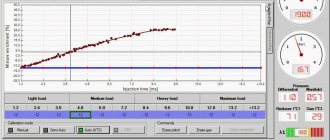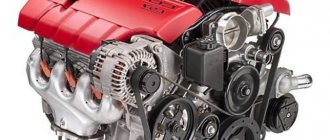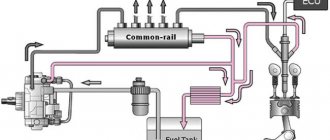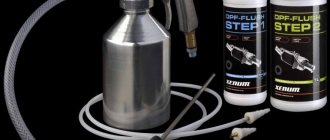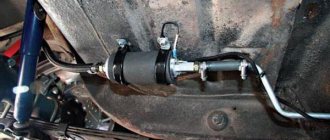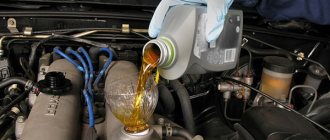A diesel engine is an engine in which the fuel is ignited by heating from compression. A standard diesel engine cannot run on gas fuel because methane has a significantly higher ignition temperature than diesel fuel (diesel fuel - 300-330 C, methane - 650 C), which cannot be achieved at the compression ratios used in diesel engines. The second reason why a diesel engine cannot operate on gas fuel is the phenomenon of detonation, i.e. non-standard (explosive combustion of fuel, which occurs when the compression ratio is excessive. For diesel engines, the compression ratio of the fuel-air mixture is 14-22 times, a methane engine can have a compression ratio of up to 12-16 times. There are two ways to convert a diesel engine to gas engine mode:
1
. Complete rework of the engine for an electric/spark ignition system (modification of the CPG, timing, cylinder head, change in the compression ratio due to possible detonation), where the gas will be ignited by spark plugs. Technical changes will be irrevocable and will completely eliminate the possibility of using D/T. This is a very expensive change that will require not only the involvement of highly paid professionals, but also complex engineering calculations. This is done extremely rarely on private transport. The most successful examples are only factory-produced gas engines (KAMAZ, Scania, YaMZ, Iveco), which run only on methane.
2
. Modernization of a vehicle by installing additional equipment, after which it becomes possible to use two types of fuel, diesel fuel and gas, the so-called Dual Fuel system or gas diesel. This is the most popular and economically justified method; it does not require permanent changes to the system. Such a car cannot run on gas alone. There are also factory models of gas diesel engines running on methane. For example, VOLVO FH/FM and KamAZ 5490 NEO with a Mercedes-Benz power plant. But such machines have not yet received widespread use.
Methods for installing HBO
One of the methods can be called radical - converting a diesel engine for operation on gas . In this case, classic spark plugs must be inserted into the cylinder head. Because gas requires a spark to ignite, unlike diesel, which ignites when pressure increases.
If space allows, then they replace the injectors or look for another possible location, and replace the diesel injectors with plugs. The gas injection system is integrated into the intake manifold. In addition, for gas it is necessary to reduce the compression ratio. To do this, install a gasket between the cylinder head and the cylinder block of increased thickness. Of course, the modification affects the wiring, electronics and fuel system. After all the modifications, a diesel engine ceases to be such. In practice, this method is extremely rare.
A diesel engine with integrated gas equipment is practically no different from a regular one.
The second method is more practical and cheaper . A diesel engine is equipped with an LPG system, which is no different from similar equipment for gasoline engines. The fuel used is a liquefied mixture of propane-butane or compressed natural gas. Moreover, methane is more profitable for diesel, since it allows it to replace up to 80% of diesel fuel in the fuel mixture. The main feature of the operation of a gas diesel engine is the ignition of the air-fuel mixture of air, gas and diesel fuel from compression. Depending on the speed, load and temperature, gas can replace up to 80% of the fuel.
Advantages and disadvantages of converting diesel to gas
The main advantage of installing gas equipment for methane, or a propane-butane mixture on a diesel engine is the reduction in fuel costs by 10-50%. In addition: • there is an increase in efficiency and motor life. At the same time, power and torque remain the same or increase, in some cases, by 5-25%; • the service life of the standard fuel system is increased by 1.5-2 times (a big plus for Common Rail systems); • harmful exhaust emissions (smoke) are reduced; • a gas engine runs smoother and its noise is reduced; • reduction of soot, deposits in cylinders, combustion chambers, particulate filters; • costs for replacing engine oil are reduced; • vehicle mileage increases in dual-fuel driving mode; • no modifications to the internal combustion engine are required. Among the serious disadvantages:
• high cost of re-equipment; • increase in time and costs for maintenance, setup, and repair of the system; • searching for places to attach cylinders, reducing the useful volume due to them; increase in vehicle weight.
Gas diesel on methane and propane-butane
If the conversion technology is not properly followed (for example, incorrect installation or absence of a temperature sensor on the exhaust manifold), the wear of the power plant can significantly increase. Since a high temperature begins to form in the combustion chamber and exhaust system when the gas-air mixture and diesel fuel explode.
Diesel engines that can be converted to gas
Any diesel engine can be converted to use gas as an additional component. It does not matter what type of fuel system is used as a base, a mechanical high-pressure fuel pump (HPF), unit injectors or a common rail. Also with on-board 12/24 V power supply. With turbine or atmospheric.
At the same time, the cost of upgrading a passenger car will be significantly less than the cost of remaking a truck engine, due to the number of cylinders installed, fasteners and multivalves for them or valves in the case of methane. Also, for engines with a large volume, 2 gas reducers are used. Their payback will also be different. The higher the diesel fuel consumption, the greater the savings from gas use. For passenger cars with low daily mileage, the payback on installing gas equipment lasts for many years. In this sense, commercial vehicles that make long regular trips benefit more. The payback period for such machines is 3-12 months. Also, the answer to the question of whether it is profitable to switch to an alternative type of fuel or whether it is better and more economical to leave “clean” diesel depends on the nature of vehicle operation.
Differences between gas equipment packages for diesel and gasoline engines
In general, the main difference between installing LPG on a diesel engine and a gasoline engine is the use of a special electronic control unit (ECU for diesel fuel) and the placement of temperature sensors on the exhaust manifold to control and prevent overheating of engine parts. In addition, on vehicles that use a mechanical fuel injection pump, an electromechanical actuator is installed that limits the supply of diesel fuel. In modern systems, this function is implemented by emulating signals from the electronic gas pedal.
Is it possible to convert diesel to gas with your own hands?
It is impossible to install all the additional devices on a diesel power unit yourself without having a serious tool base in your personal farmstead or garage. The most labor-intensive operations are: • Connecting gas equipment. • Adaptation/synchronization of the standard fuel system. • Installation of instrumentation and electronics. In addition, special software will be required to configure and adjust the system. But if there is a strong desire, re-equipment is possible. It is important not to forget about the mandatory registration of an additional fuel installation, which is not a quick procedure. Where relevant documents from the service station will also be required.
Will engine performance change when running on methane?
Power
.
There is a common belief that when using methane, an engine loses up to 25% in power. This opinion is true for dual-fuel gasoline-gas engines and is partly true for naturally aspirated diesel engines. For modern engines equipped with supercharging, this opinion is erroneous. The high strength life of the original diesel engine, designed to operate with a compression ratio of 16-22 times, and the high octane number of gas fuel allow us to use a compression ratio of 12-14 times. Such a high compression ratio makes it possible to obtain the same (and even greater) specific power when operating on stoicheometric fuel mixtures. However, meeting toxicity standards above EURO-3 is not possible, and the thermal stress of the converted engine also increases. Modern inflatable diesel engines (especially with intercooling of the inflatable air) make it possible to operate on significantly lean mixtures while maintaining the power of the original diesel engine, keeping the thermal regime within the same limits and meeting EURO-4 toxicity standards. For naturally aspirated diesel engines, we offer 2 alternatives: either reducing operating power by 10-15% or using a water injection system into the intake manifold in order to maintain an acceptable operating temperature and achieve EURO-4 emission standards. Moment
.
The maximum torque will not change and may even be slightly increased. However, the point at which maximum torque is achieved will shift towards higher speeds. This is certainly not pleasant, but in practice drivers hardly complain and quickly get used to it, especially if there is a reserve of engine power. A radical solution to the problem of shifting the torque peak for a gas engine is to replace the turbine with a special type of oversized turbine with a high-speed wastegate solenoid valve. However, the high cost of such a solution does not give us the opportunity to use it for individual conversion. Reliability
.
The engine resource will increase significantly. Since gas combustion occurs more evenly than diesel fuel, the compression ratio of a gas engine is less than that of a diesel engine and the gas does not contain foreign impurities, unlike diesel fuel. Oil
.
Gas engines are more demanding on oil quality. We recommend using high-quality all-season oils of SAE 15W-40, 10W-40 classes and changing the oil at least 10,000 km. If possible, it is advisable to use special oils, such as LUKOIL EFFORSE 4004 or Shell Mysella LA SAE 40. This is not necessary, but with them the engine will last a very long time. Due to the higher water content in the combustion products of gas-air mixtures in gas engines, problems with the water resistance of motor oils may arise, and gas engines are also more sensitive to the formation of ash deposits in the combustion chamber. Therefore, the sulfate ash content of oils for gas engines is limited to lower values, and the requirements for oil hydrophobicity are increased. Noise
. You will be very surprised! A gas engine is a very quiet car compared to a diesel engine. The noise level will decrease by 10-15 dB according to instruments, which corresponds to 2-3 times quieter operation according to subjective sensations.
What mileage will be on one methane filling station?
Methane on board the vehicle is stored in a gaseous state under high pressure of 200 atmospheres in special cylinders. The large weight and size of these cylinders is a significant negative factor limiting the use of methane as a gas engine fuel. LLC "RAGSK" uses high-quality metal-plastic composite cylinders (Type-2) certified for use in the Russian Federation. The inside of these cylinders is made of high-strength chrome-molybdenum steel, and the outside is wrapped in fiberglass and filled with epoxy resin. To store 1 nm3 of methane, 5 liters of hydraulic cylinder volume are required, i.e. for example, a 100 liter cylinder allows you to store approximately 20 nm3 of methane (actually a little more, due to the fact that methane is not an ideal gas and is better compressed). The weight of 1 liter of hydraulic is approximately 0.85 kg, i.e. the weight of a storage system for 20 nm3 of methane will be approximately 100 kg (85 kg is the weight of the cylinder and 15 kg is the weight of the methane itself). Type-2 cylinders for storing methane look like this:
In practice, it is usually possible to achieve the following mileage values: 200-250 km
- for minibuses.
Storage system weight - 250 kg 250-300 km
- for medium-sized city buses.
Storage system weight - 450 kg 500 km
- for truck tractors. Storage system weight - 900 kg You can obtain specific mileage values on methane for your car by filling out a conversion application by clicking the red button at the end of this page.
What does the equipment consist of?
At its core, gas equipment for diesel engines is no different from the classic fourth-generation gas equipment set for gasoline engines. The following is installed in the car:
- cylinder for liquefied or natural gas;
- gearbox with integrated evaporator (methane heater);
- solenoid valve;
- filters;
- injection system with nozzles;
- electronic control unit connected to the gas equipment and vehicle sensors.
Depending on the manufacturer, an additional injector operation emulator may be installed along with electronic actuators for “original” diesel injectors. This allows gas equipment to take control of the fuel supply and control its quantity.
The main feature of LPG for a diesel engine is the operation of electronics, which regulates the proportion of fuel and gas. To do this, the gas equipment ECU takes over control of the diesel injectors.
Let's sum it up
So, we found out whether it is possible to install gas on a diesel engine. Due to a different operating principle, installing an LPG on such a motor requires major modifications. Moreover, as a result, this unit will still require, albeit a small, portion of diesel. There are savings from using such equipment. But it is so insignificant that no one bothers with the question “is it worth installing gas on a diesel engine?” High payback periods and installation complexity are the main factors that prevent the use of gas-cylinder equipment on a diesel engine.
How does gas diesel work?
When installing methane or propane, remember that diesel fuel is used constantly. Only its quantity in the fuel mixture changes. When “cold” and at low speeds, the system practically does not add gas. This allows the engine to operate stably, maintaining high torque at low speeds. With increasing speed and moderate load, the amount of gas increases and the amount of diesel fuel decreases, which reduces refueling costs.
Diagram of operation of gas diesel equipment with an additional control unit
There is no need to turn the gas on and off, although this is possible. The transition from one type of fuel to another occurs unnoticed by the driver. An engine that runs on diesel and gas simultaneously is called a gas-diesel engine. They tried to produce the first serial factory samples back in the USSR on KAMAZ trucks, but then they considered the project economically unprofitable, but now factory versions of gas-diesel are already being sold.
Gas equipment can be used on both atmospheric and turbocharged diesel engines.
Installation of gas diesel engines in trucks in Moscow
50 - 85% replacement of diesel fuel with natural gas
Fill out an application on the website, we will contact you as soon as possible and answer all your questions.
Order service
Gas diesel is a diesel engine retrofitted to operate with gas, in which the gas-air mixture is ignited by a small portion of liquid fuel injected into the cylinder during the compression process.
Main advantages of gas diesel:
Economical
: installation of gas-diesel equipment can significantly reduce diesel fuel costs. Since natural gas is about three times cheaper than diesel fuel.
Environmental friendliness of natural gas
: the use of gas diesel can significantly reduce the level of toxicity of exhaust gases. Natural gas has the lowest toxic emissions among other popular fuels.
Increased engine life
: HBO is an opportunity to extend the service life of the engine. Natural gas contains no harmful impurities, due to which the accumulation of tar deposits in the engine is minimized.
Gone are the days when you had to make a choice between the efficiency of a gas engine and the ability to drive in any road conditions on diesel fuel. Today there are gas-diesel, or as they are also called dual-fuel, engines. This option of internal combustion engine is a real money saving on diesel fuel in the amount of 25-30%. Thanks to the gas-diesel engine, the car turns into a vehicle capable of traveling on diesel fuel, almost completely replacing it with gas.
Average fuel cost in Russia:
Diesel:
Methane:
Average annual savings for our clients:
Note:
- The calculation was made under the conditions that the car operates 300 days a year.
- The degree of substitution of diesel fuel can vary widely for methane from 50% to 85%; for calculations we use an average of 65%
- Daily mileage 600km
Gas-diesel mode:
- Replacement rate - 65%
- Diesel fuel consumption per 100 km - 15.75 liters
- The cost of 100 km on diesel fuel is 756 rubles
- Expenses for diesel fuel per year - RUB 1,360,800
- Gas consumption per 100 km - 29.25 nm3
- The cost of 100 km on GAS is 497.25 rubles
- Expenses for GAZ per year - 895,050 rubles
- Saving per 100 km - 906.75 rubles
- Total annual consumption of GAZ+DT—RUB 2,255,850
Diesel mode:
- Annual mileage - 180,000 km
- Diesel fuel consumption per 100 km - 45 liters
- The cost of 100 km on diesel fuel is 2,160 rubles
- Expenses for diesel fuel per year - RUB 3,888,000
Savings for every 1000 km driven:
Payback:
*your personal manager will inform you about the exact payback period
Commercial offer:
Download the commercial offer or call the number and the master consultant will answer all your questions and tell you about the benefits and advantages: 8
Request an individual commercial offer
We offer to install LPG on trucks with a diesel engine at competitive prices. Take advantage of the BEST PRICE GUARANTEE promotion - we offer the best price for gas-diesel in Moscow, find a cheaper price and after checking we will give you a better offer!
*price for each car may vary, the exact price will be announced by the manager over the phone
Find out the cost of "Gas-diesel"
Why customers choose GARANT-GAZ to install Gas Diesel:
Experience over 20 years
: The company has many years of practice and has vast experience in working with gas equipment since 1997, thanks to which it makes the right choice in favor of one or another gas equipment manufacturer.
Accredited partner of Gazprom GMT
: which allows our clients to take advantage of special conditions for the installation of gas diesel engines. The company is a member of the National Gas Engine Association and the Moscow Chamber of Commerce and Industry
We work seven days a week from 9:00 to 20:00
: which is very convenient for customers, during further maintenance of the vehicle fleet, our specialists are ready to provide both technical and information support.
Only professionals
: The company’s specialists undergo training and continuous training at automotive universities in Moscow, at equipment manufacturing plants in Poland and Italy.
3 year warranty
: We work only with certified equipment, which allows us to provide a 2-year warranty on equipment and work!
Payment Methods:
Bank transfer
Bank transfer to a current account is available for legal entities, payment is possible with VAT 20% and without VAT
Cash
We provide clients with a 3% discount on the cost of installing a gas diesel engine
Installment plan
The installment plan is issued in our office, we take on all the costs when working with banks, for you the overpayment will be 0%!
Credit card
Payment by credit card is possible, we accept Visa, MasterCard, Maestro, MIR cards for payment
Helpful information:
Source: https://garant-gaz.ru/gasodisel/
Advantages and disadvantages
The main advantage of methane or propane on diesel is reduced fuel costs. Savings can range from 10% to 25%. Maximum efficiency is felt when driving at medium speeds on country roads.
Truck with installed composite gas cylinders
Among the disadvantages are the long payback period for urban use or low mileage, the cost of re-equipment, as well as the presence of additional components that may fail.
What is needed to install gas equipment on diesel?
- Control block. The main thing in this system. It consists of controllers and controls the operation of the kit.
- Fuel pump One of the most important components. Needed to supply fuel. If you use gas, you will have to convert it.
- Reducer-evaporator. In cylinders, propane is in a liquid state. A reduction evaporator is needed to convert it into gas. Methane is already in a gaseous state, but a reducer is still needed to maintain pressure.
- Gas injectors. Necessary for supplying gas to the combustion chamber.
- Fuel switch. It is necessary that the driver can manually change the fuel at will.
- Temperature, synchronization, gas sensors and others. Needed for the engine. Used to create a mixture.
- Gas cylinder. Quite large size. That's where the gas is.
- Highway. This is the tube that carries gas from the cylinder to the engine.
- Refueling devices. Needed for gas refilling.
- Multivalve. This is necessary so that the gas can enter and exit the cylinder.
- Protective equipment. Necessary to protect the cylinder from overfilling and releasing excess pressure.
- Filter. Responsible for purifying gas from impurities and debris.
As you can see, diesel fuel gas has a lot of advantages. It is indispensable for trucks and large equipment.
Payment for HBO 10%
Increasing state subsidies for natural gas motor fuel.
New information has appeared (news statement dated June 16, 2020) that 60% of the costs of switching vehicles to LPG are now paid by the government.
Energy Minister Alexander Novak explained that compressed natural gas (methane) is an environmentally friendly and economical type of fuel. Therefore, the government’s task is to support the gas engine industry.
From 2022 to 2024, the government will actively finance this area. In total, the state plans to invest 50 billion rubles. To re-equip one car, it takes from 80 to 150 thousand rubles. Alexander Novak predicts that new increased subsidies will make this procedure more affordable. Doubling the size of subsidies will make the transition to CNG feasible for 10-12 thousand cars already in 2022.
Government subsidies for converting vehicles to gas now cover 60% of costs instead of 30%. This applies to both individuals and legal entities. These subsidies significantly reduce the cost of converting a car to LPG. Now is the best time for this!
